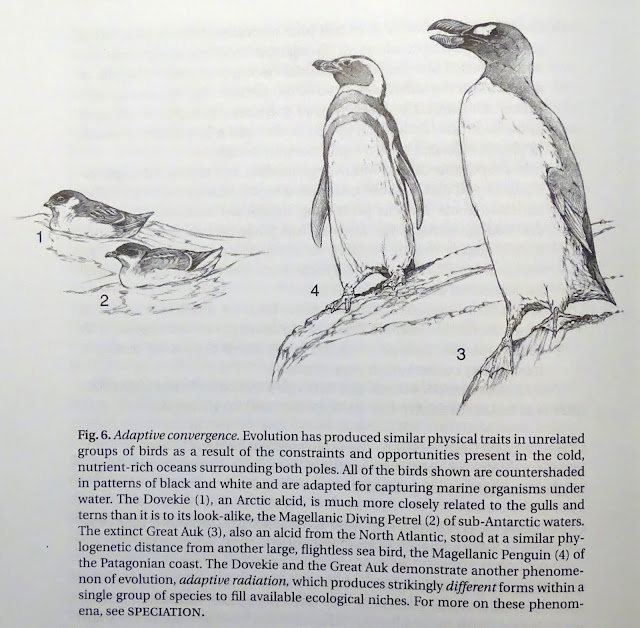 |
Razorbills
|
 |
Razorbill
|
 |
Dovekie
|
Dovekies were the advertised prize goal for the Brookline Club tour. For many in the group it would be a Life Bird, meaning their first authenticated sighting if they had a lucky day.
 |
Black guillemot, fall-winter
plumage
|
 |
Black guillemot,
breeding plumage
|
 |
Thick-billed murre
and Common eider
|
 |
Common murre
|
In the region where alcids live, their principal seabird competition are cormorants (which are dive-powered by their strong feet). In areas where the two groups feed on the same prey, the alcids tend to feed further offshore.
You will have noticed similarities in appearance between alcids and penguins. This carries over to their strong swimming ability and the use of their wings to gain speed and agility underwater. Both groups stand with an upright posture on land because their legs are located relatively far to the rear for best diving propulsion.
Although not to the extent of penguins, alcids have largely sacrificed flight, and also mobility on land, in exchange for swimming ability; their wings are a compromise between the best possible design for diving and the bare minimum needed for flying. [Much of the foregoing is from Wikipedia.]
Examples of Convergent
Evolution:
(1) Dovekie's
resemblance to (2) Diving petrel
(3) Razorbill's
resemblance to (4) Magellanic penguin
Chris Leahy, The
Birdwatcher's Companion
It would be easy to suppose that alcids and penguins are linked by common ancestors. However genetic analyses have demonstrated that their similarities have developed from independent like responses to similar ecological circumstances. Very different ancestors evolved to specialize on the same feeding opportunities to produce look-alike species in a process known as adaptive convergence.
Local resident Chris Leahy presents authoritative and alluring information such as this in his encyclopedic Birdwatcher's Companion (2004).
For the book's cover illustration he has chosen a pair of nesting Tufted puffins, Pacific relative of the Atlantic Puffin alcid I have yet to see at Halibut Point. One of these nor'easters I may squint into the winds, sleet, and frigid temperatures that drive pelagic birds toward shore in hopes of that first sighting. So far I've excused myself for the sake of my camera. Chris says that "in flight off Halibut in winter plumage they are easily overlooked: small, dull (no big colorful bill sheath) flying fast close to the water." And probably half way to the horizon. Happy birding to you!


Excellent explanation, Martin, with beautiful photos. Happy birding to you.
ReplyDelete